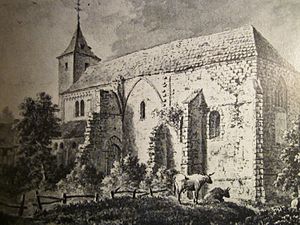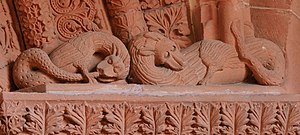St. Norbert (Enkenbach)
|
West facade with vestibule |
|
| Basic data | |
| Denomination | Catholic |
| place | Enkenbach-Alsenborn, Germany |
| diocese | Diocese of Speyer |
| Patronage | Norbert von Xanten |
| Building history | |
| construction time | around 1225 - 1272 |
| Building description | |
| Architectural style | Late Romanesque |
| Furnishing style | Cross arm, choir |
| Construction type | Vaulted basilica |
| 49 ° 29 '10.3 " N , 7 ° 53' 58" E | |
The Catholic parish church St. Norbert in Enkenbach in the district of Kaiserslautern in Rhineland-Palatinate was the monastery church of a Premonstratensian monastery , which was founded in 1148 by Count Ludwig III. by Arnstein and Ritter Hunefried von Alsenborn. The construction of the church dates back to the 13th century and has been partly demolished, rebuilt and restored several times in the course of history, but the main parts have been preserved.
History and building history
The monastery Enkenbach was a filiation of Arnstein Abbey founded a double monastery and belonged as Marienthal and Münsterdreisen to Zirkarie Wadgassen . In the course of the 13th century it was transformed into a pure nunnery. The construction of today's church took place in two construction periods, beginning around 1225. The second period can be dated from 1265 to 1272 on the basis of documents. Until the 13th century the monastery was under the protection of the Raugrafen von Daun and Wartenberg and in 1271 it went to the Bishop of Worms. From 1404 until the dissolution, the Palatinate took over the patronage of the monastery. After the penultimate provost Michael Reybold had turned to the Lutheran doctrine and in 1557 handed over the monastery to Elector Ottheinrich , the final repeal was in 1564 by Friedrich III. completed. The building was destroyed in the Reunion War in 1689. After the church was split up in 1706, the monastery church came back into the possession of the Catholics. Restoration work was carried out in 1707-08, whereby the south transept remained as a ruin. From 1902 to 1904 a fundamental renovation was carried out by Wilhelm Schulte from Neustadt / Haardt, which particularly concerned the re-romanization of the choir and the restoration of the transept.
Until the dissolution of the convent, he had extensive property and the parish record in the no longer existing village of Eyersheim near Weisenheim am Sand .
description
The building is an asymmetrical cross-rib vaulted pillar basilica with a transept and choir. On the west side there is a vestibule with a simple single-tower facade. Stylistically, the building is in transition to Gothic and has similarities to the nearby Otterberg Abbey . Similar to Otterberg, there is a rose window above the main entrance . The re-romanization of 1902-04 partially removed Gothic style elements, apparently on the redesign of the west side of the south aisle. The remaining areas of the west facade show pointed arches in the basement. These are repeated inside on the north aisle arcades. These show a variant of the Saxon column change : In the Echternach column change, two coupled pointed arch arcades are set between each two pillars, which are separated by a column. This pair of arcades is covered by a round blind arch that stretches from pillar to pillar.
The south aisle, which was originally only connected to the main aisle by two openings, formed a wing of the cloister, which no longer exists. It was not until 1971 that the current situation, which obscures the original spatial situation, was created.
The architectural sculpture on consoles and capitals is also related to Otterberg, the Worms Cathedral and Strasbourg Cathedral can be assumed as models.
The step portal between the vestibule and the central nave has a remarkable tympanum , which shows animals incorporated in foliage, which probably represent the Last Judgment in symbolic form . The Lamb of God is at the center. "Unclean" animals (rabbit, pig, squirrel and dog) are on its left side, on the right side you can see four birds that are considered pure animals. To the side you can see lions and dragons arranged in pairs.
Bells
The oldest still preserved bell is the Marienglocke from 1920, which was the only one of the previous bells to be preserved during the Second World War . The bell founder Karl Czudnochowsky from Erding, who was also a native of Enkenbach, cast three new bells in 1949 to complement the existing interwar bell. It is one of his best quality cast bells ever.
| No. | Surname | volume | Casting year | Foundry, casting location |
Weight (kg) |
| 1 | Christ the King | e 1 | 1949 | Karl Czudnochwsky, Erding | 1100 |
| 2 | St. Joseph | g sharp 1 | 520 | ||
| 3 | St. Mary | h 1 | 1920 | Ulrich, Apolda | 420 |
| 4th | St. Peter | c sharp 2 | 1949 | Karl Czudnochwsky, Erding | 200 |
literature
- Jürgen Keddigkeit / Mathias Untermann: Enkenbach, .St. Maria, Premonstratensian monastery, later Premonstratensian prostitute. In: Pfälzisches Klosterlexikon vol. 1 A – G (contributions to the history of the Palatinate vol. 26.1), ed. v. Jürgen Keddigkeit / Mathias Untermann / Hans Ammerich / Pia Heberer / Charlotte Lagemann, Kaiserslautern 2014, ISBN 978-3-927754-76-8 , pp. 378–404.
- Franz Hafner, monastery and monastery church Enkenbach, Speyer 1972
- Clemens Jöckle, Enkenbach St. Norbert, Schnell, Art Guide No. 1285, Munich and Zurich 1981
- Georg Dehio : Handbook of the German art monuments. Rhineland-Palatinate Saarland , edited by Hans Caspary, Wolfgang Götz and Ekkart Klinge, Deutscher Kunstverlag 1972: Enkenbach-Alsenborn, pp. 214–217.
- Enkenbach. In: Ludwig Petry (ed.): Handbook of the historical sites of Germany . Volume 5: Rhineland-Palatinate and Saarland (= Kröner's pocket edition . Volume 275). 3rd revised edition. Kröner, Stuttgart 1988, ISBN 3-520-27503-1 , p. 92f.





